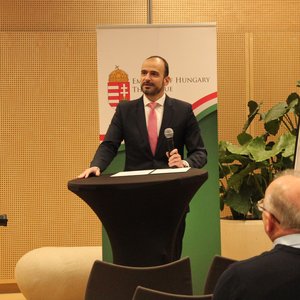Symposium on von Neumann: perhaps the greatest mathematician in modern history
John von Neumann (1903-1957) was a Hungarian-American mathematician who made essential contributions not only in mathematics but also in physics, computer science and economics. In many ways he shaped the future we live in. The Embassy of Hungary in the Netherlands, in cooperation with Júlia Komjathy of the EEMCS faculty, organised a symposium commemorating the remarkable legacy of one of the greatest - but relatively unknown - mathematicians in modern history.
Embedded systems
Von Neumann was a child prodigy and mastered calculus by the age of eight. He also worked on one of the first electronic computers, the ENIAC, and designed the computer architecture for its proposed successor, the EDVAC. In computers with this architecture, the processor and working memory are separate entities, and the data and programme are loaded into the working memory. It is 120 years since von Neumann's birth, and his computer architecture is still used in practically every computer, from laptop to smartphone.
But von Neumann himself was already raising questions about his architecture. He was interested in the brain, and compared it to computers. He suspected that in the brain, processing power and memory are not two separate things. In computers with von Neumann architecture, processors and memory are separate and yet they need to constantly communicate with each other. But that communication consumes about a thousand times more energy than the actual computation.
Georgi Gaydadjiev, professor of Computer Science at the EEMCS Faculty, gave a lecture on computer architecture and embedded systems, which are computers with the memory and processor all rolled into one. His goal is to minimise data movement at all system levels. This is a topic we focus on extensively within the faculty, in the context of developments within computer science and energy efficiency. Besides, Gaydadjiev demonstrated that novel non-von Neumann architectures might solve the current bottleneck in improving processor speeds: the fact that silicon semiconductors have now become so small, they near the size of atoms.
Two studies at once

| Von Neumann had a great passion for mathematics, but his father, Max, disapproved. There was no way he could earn enough money from it, argued Max. "John was eventually allowed to study for a doctorate in mathematics at the University of Budapest, but only if he would also study chemical engineering at the same time," H.E. András Kocsis, Hungary's ambassador explained in his welcome speech. |
The foundation of mathematics
And so it happened. Von Neumann obtained a degree in chemical engineering from ETH Zurich along with his doctoral degree in mathematics at the age of 23. He wrote a dissertation in the field of set theory. "Von Neumann's work in set theory forms the basis from which almost all of mathematics can be derived," explained Professor Gabor Elek, during his lecture on von Neumann's algebra. Von Neumann rescued set theory from Russell’s paradoxes, and made the language of mathematics ‘safe’.
Sharper than Einstein
The fact that von Neumann is relatively unknown is surprising, to say the least. Because, as Dr Ananyo Bhattacharya, author of the book 'The Man from the Future' stated during the symposium, "Von Neumann's colleagues believed that he had -without exception- the fastest brain in the world. He was sharper than Einstein." Von Neumann was involved in many other fields - besides mathematics, neuroscience and computer architecture. He helped lay the foundations for quantum mechanics. He played an important role in designing the atomic bomb during the Manhattan Project. His work inspired nanotechnology and he developed a universal constructor: a theoretical machine that can replicate itself.
Game theory: von Neumann's hobby
In his spare time, he researched Game Theory for application within economics. Researcher Oskar Morgenstern, with whom von Neumann wrote a book on the subject, described this as the busiest period of his life. But to von Neumann, this was a hobby. Nevertheless, according to Professor Eric van Damme - as he explained during his symposium lecture - it was indeed really von Neumann who laid the foundations for Game Theory in 1928 with his proof of the ‘minimax theorem’.
John von Neumann's legacy still lives on. This was demonstrated by the enthusiastic audience of the symposium: the room was filled with more than 70 participants, ranging from master and PhD students, to young and old staff at EEMCS, to emeritus professors. The audience united in laughing about how we resolve math paradoxes - like the famous Banach–Tarski paradox which states that you can cut an apple into pieces and reassemble it into two identical apples. And they also united in their appreciation of smart computer design nearing the quantum boundary. Von Neumann's heritage still drives science forward, also at our university.
